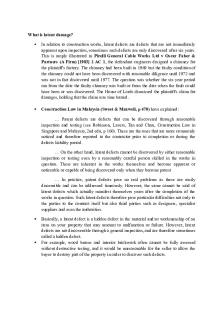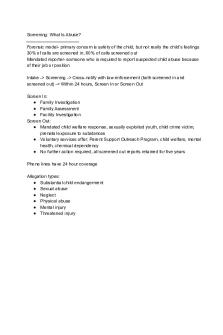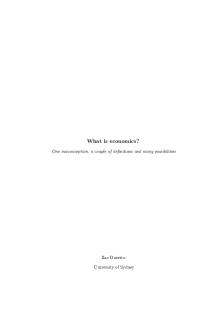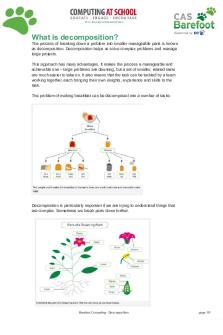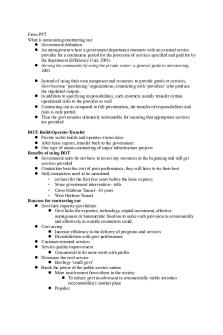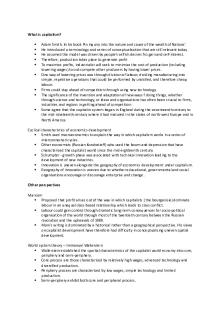What is latent damage - Lecture notes 6 PDF

| Title | What is latent damage - Lecture notes 6 |
|---|---|
| Course | Tort Law |
| Institution | Multimedia University |
| Pages | 3 |
| File Size | 103.5 KB |
| File Type | |
| Total Downloads | 101 |
| Total Views | 145 |
Summary
Download What is latent damage - Lecture notes 6 PDF
Description
What is latent damage?
In relation to construction works, latent defects are defects that are not immediately apparent upon inspection, sometimes such defects are only discovered after six years. This is amply illustrated in Pirelli General Cable Works Ltd v Oscar Faber & Partners (A Firm) [1983] 2 AC 1, the defendant engineers designed a chimney for the plaintiff's factory. The chimney had been built in 1969 but the faulty condition of the chimney could not have been discovered with reasonable diligence until 1972 and was not in fact discovered until 1977. The question was whether the six year period ran from the date the faulty chimney was built or from the date when the fault could have been or was discovered. The House of Lords dismissed the plaintiff's claim for damages, holding that the claim was time barred.
Construction Law in Malaysia (Sweet & Maxwell, p 470) have explained: … Patent defects are defects that can be discovered through reasonable inspection and testing (see Robinson, Lavers, Tan and Chan, Construction Law in Singapore and Malaysia, 2nd edn, p 160). These are the ones that are more commonly noticed and therefore reported to the contractor prior to completion or during the defects liability period. … On the other hand, latent defects cannot be discovered by either reasonable inspection or testing even by a reasonably careful person skilled in the works in question. These are inherent in the works themselves and become apparent or noticeable or capable of being discovered only when they become patent … In practice, patent defects pose no real problems as these are easily discernible and can be addressed timeously. However, the same cannot be said of latent defects which actually manifest themselves years after the completion of the works in question. Such latent defects therefore pose particular difficulties not only to the parties to the contract itself but also third parties such as designers, specialist suppliers and even the authorities.
Basically, a latent defect is a hidden defect in the material and/or workmanship of an item on your property that may amount to malfunction or failure. However, latent defects are not discoverable through a general inspection, and are therefore sometimes called a hidden defect. For example, wood beams and interior brickwork often cannot be fully assessed without destructive testing, and it would be unreasonable for the seller to allow the buyer to destroy part of the property in order to discover such defects.
Section 6(1)(a) of the Limitation Act 1953 ("Limitation Act")
Any action must be brought within six years from when a cause of action accrued regardless of when the plaintiff discovers such damage. This is affirmed by the Court of Appeal in AmBank (M) Bhd v Abdul Aziz Hassan & Ors [2010] 3 MLJ 784. When presented with the argument of postponing or extending the statutory limitation period for negligence claims based on the discovery of the damage, the Court of Appeal held that section 6(1)(a) of the Limitation Act should be interpreted in a literal manner. Further, the Court of Appeal ruled that the notion of postponing or extending limitation to include the element of discovery is not provided for in the Limitation Act or in any other Malaysian law. This case may seem unfair, particularly in cases of latent defects.
The Applicability of Section 6A
Section 6A to apply only to latent damage in construction cases.
Prior to the introduction of the Act, the Court of Appeal in AmBank (M) Bhd v Kamariyah bt Hamdan & Anor [2013] 5 MLJ 448 (Kamariyah) attempted to lessen the unfairness caused by the strict interpretation of section 6(1)(a) in Abdul Aziz by introducing the “discoverability rule”. His Lordship held that limitation should run from the date the damage was discovered, or ought to have been discovered. When invited to consider Abdul Aziz, the learned judge held, “… we must respectfully decline to defer to the ruling that time would run regardless of whether damage was or could be discovered”
In KC Leong Holdings Sdn Bhd v Datin Moh Bee Ling [2015] 7 MLJ 10, the defendant alleged that the constructed bungalows were not fit for its purpose of occupation by reason that there were gross and latent defects and accuses the plaintiff negligently constructed them. Court held it is trite law that the defendant must prove that the alleged defects were caused by the plaintiff as a matter of fact. The classic maxim that she who asserts must prove her assertion applies here as codified in s 101 of the Evidence Act 1950. The causation of a defect can however be due to design, quality of material used, workmanship, lack of maintenance, wear and tear or a combination of them. The defendant must therefore produce cogent evidence that the cause of the defect as alleged is plainly attributable to the plaintiff. In this regard, the defendant obviously cannot blame the plaintiff if the defect is due to lack of proper and regular maintenance. Likewise the plaintiff would be exonerated if the defect is due to design fault since this is not a design and build contract as earlier found. In the premises the plaintiff would be liable to the defendant in damages within the limitation period as prescribed by the Limitation Act 1953 for defects that were caused by the plaintiff in breach of contract due to work carried out not to a good and workmanlike manner. The defendant has not sufficiently proved that all her
allegations of latent defects were in fact and law the responsibility of the plaintiff. There was grave dispute over the final accounting of the project between the defendant and the plaintiff. Consequently, the defendant has in my view gone ahead to rectify all purported defects encountered in the without proper analysis and allocation of blameworthiness and thereafter simply backcharged the costs incurred onto the plaintiff.
An example of a case involving latent defects considering the "discoverability rule" would be The Ara Joint Management Body v Mammoth Land & Development Sdn Bhd [2017] MLJU 631. The case involved latent defects discovered in the buildings of The Ara Bangsar Development. The alleged defects were discovered sometime in 2014, 7 years after construction was completed in 2007. The plaintiff, the joint management body of the development, brought an action on behalf of the residents against the developer for latent defects in October 2016, some 9 years after the construction had been completed. The developer attempted to rely on Abdul Aziz to strike out the case on the grounds that the claim was time-barred. The plaintiff, on the contrary, argued that the "discoverability rule" should be adopted. Lee Swee Seng J, in dismissing the developer's striking-out application, held the preferred test would be a matter of fact i.e. when the damage was discovered. His Lordship then dismissed the striking out application and set the matter for trial.
When section 6A comes into force on 1 September 2019, there will be three tests to determine limitation for negligence not amounting to personal injury: 1. Abdul Aziz (limitation starts from the date of damage) 2. Kamariyah (limitation starts from the date of discovery or when discovery ought to have happen) 3. Section 6A (limitation starts from the date of discovery for the period of 3 years, after the expiry of 6 years and is subject to a longstop of 15 years)....
Similar Free PDFs
Popular Institutions
- Tinajero National High School - Annex
- Politeknik Caltex Riau
- Yokohama City University
- SGT University
- University of Al-Qadisiyah
- Divine Word College of Vigan
- Techniek College Rotterdam
- Universidade de Santiago
- Universiti Teknologi MARA Cawangan Johor Kampus Pasir Gudang
- Poltekkes Kemenkes Yogyakarta
- Baguio City National High School
- Colegio san marcos
- preparatoria uno
- Centro de Bachillerato Tecnológico Industrial y de Servicios No. 107
- Dalian Maritime University
- Quang Trung Secondary School
- Colegio Tecnológico en Informática
- Corporación Regional de Educación Superior
- Grupo CEDVA
- Dar Al Uloom University
- Centro de Estudios Preuniversitarios de la Universidad Nacional de Ingeniería
- 上智大学
- Aakash International School, Nuna Majara
- San Felipe Neri Catholic School
- Kang Chiao International School - New Taipei City
- Misamis Occidental National High School
- Institución Educativa Escuela Normal Juan Ladrilleros
- Kolehiyo ng Pantukan
- Batanes State College
- Instituto Continental
- Sekolah Menengah Kejuruan Kesehatan Kaltara (Tarakan)
- Colegio de La Inmaculada Concepcion - Cebu
